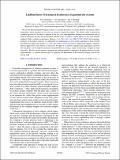Files in this item
Lindblad theory of dynamical decoherence of quantum-dot excitons
Item metadata
| dc.contributor.author | Eastham, P R | |
| dc.contributor.author | Spracklen, A O | |
| dc.contributor.author | Keeling, Jonathan Mark James | |
| dc.date.accessioned | 2014-06-04T15:01:01Z | |
| dc.date.available | 2014-06-04T15:01:01Z | |
| dc.date.issued | 2013-05-15 | |
| dc.identifier | 52965629 | |
| dc.identifier | e41b6aab-dca8-492c-befa-8e159e88f47b | |
| dc.identifier | 84877915274 | |
| dc.identifier | 000319115500006 | |
| dc.identifier.citation | Eastham , P R , Spracklen , A O & Keeling , J M J 2013 , ' Lindblad theory of dynamical decoherence of quantum-dot excitons ' , Physical Review. B, Condensed matter and materials physics , vol. 87 , no. 19 , 195306 . https://doi.org/10.1103/PhysRevB.87.195306 | en |
| dc.identifier.issn | 1098-0121 | |
| dc.identifier.other | Bibtex: urn:f88e1fa5f33378c0524de14415e5b81a | |
| dc.identifier.other | ORCID: /0000-0002-4283-552X/work/27559427 | |
| dc.identifier.uri | https://hdl.handle.net/10023/4851 | |
| dc.description.abstract | We use the Bloch-Redfield-Wangsness theory to calculate the effects of acoustic phonons in coherent control experiments where quantum-dot excitons are driven by shaped laser pulses. This theory yields a generalized Lindblad equation for the density operator of the dot, with time-dependent damping and decoherence due to phonon transitions between the instantaneous dressed states. It captures similar physics to the form recently applied to Rabi oscillation experiments [Ramsay et al., Phys. Rev. Lett. 104 017402 (2010)] but guarantees positivity of the density operator. At sufficiently low temperatures, it gives results equivalent to those of fully non-Markovian approaches [Lüker et al., Phys. Rev. B 85 121302 (2012)] but is significantly simpler to simulate. Several applications of this theory are discussed. We apply it to adiabatic rapid passage experiments and show how the pulses can be shaped to maximize the probability of creating a single exciton using a frequency-swept laser pulse. We also use this theory to propose and analyze methods to determine the phonon density of states experimentally, i.e., phonon spectroscopy, by exploring the dependence of the effective damping rates on the driving field. | |
| dc.format.extent | 11 | |
| dc.format.extent | 1919125 | |
| dc.language.iso | eng | |
| dc.relation.ispartof | Physical Review. B, Condensed matter and materials physics | en |
| dc.subject | QC Physics | en |
| dc.subject.lcc | QC | en |
| dc.title | Lindblad theory of dynamical decoherence of quantum-dot excitons | en |
| dc.type | Journal article | en |
| dc.contributor.sponsor | EPSRC | en |
| dc.contributor.sponsor | EPSRC | en |
| dc.contributor.institution | University of St Andrews. School of Physics and Astronomy | en |
| dc.contributor.institution | University of St Andrews. Condensed Matter Physics | en |
| dc.identifier.doi | 10.1103/PhysRevB.87.195306 | |
| dc.description.status | Peer reviewed | en |
| dc.identifier.url | http://link.aps.org/doi/10.1103/PhysRevB.87.195306 | en |
| dc.identifier.grantnumber | EP/G004714/1 | en |
| dc.identifier.grantnumber | EP/I031014/1 | en |
This item appears in the following Collection(s)
Items in the St Andrews Research Repository are protected by copyright, with all rights reserved, unless otherwise indicated.

